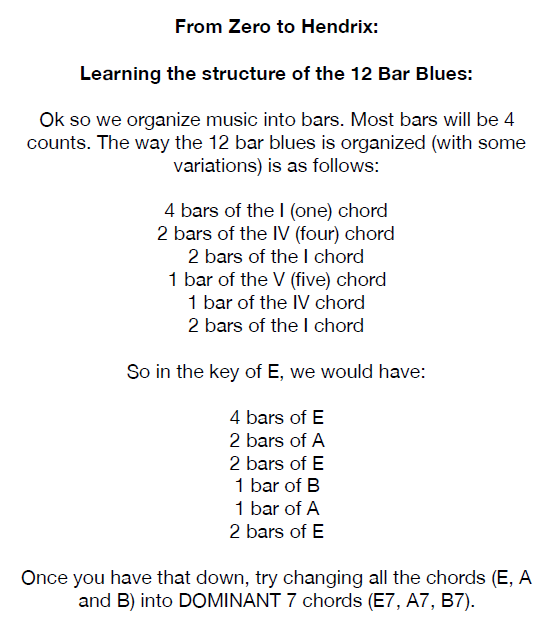
In this Guitar Control lesson video instructor Sean Daniel, will show you how to play “Basic 12 Bar Blues Chord Progression”.
Check the image above to follow the chords and tabs.
A lot of people don’t usually equate beginner guitar with Jimi Hendrix, I personally think the Jimi Hendrix is the best guitar player who has ever lived and one of the main reasons I started playing guitar. I think it’s important to start playing in the general idea of what you want to sound, end goal. Though maybe you’re just starting out, haven’t playing long or maybe even playing for a while and haven’t really taken that next steps. Try to break into something that sounds a little more like Hendrix.
It’s never too early to get started thinking about how Jimi thinks and how he started composing a song, basically what he was doing the entire time is, he was very influenced by the blues. The very first thing, we have to do is understanding blues music structure and that’s the 12-bar blues, we’ve got our East 7, 1 chord, our a7 4 chord, and our b75 chords, now let’s put those plug into the formula.
All down strokes four, and four to three, to the four, four, one, two, three, four, another bar, the two bars of the 1 e7, for one bar of the 5/4 alarm the floorboard, and then bar of the one, two bars the one corner. Those are just the chords in a traditional 12 bar blues, that’s the very basic structure of what we are doing. One thing I would like to encourage you to do, if again those chord changes are kind of difficult, just play the one chord as a e7 chord one, two, and then switch this in the four chord.
Do a power four, one, two, three, four, back to E, and then again, if that B power chord is getting that that stretching, hit the single note 4 times, then open the a string and then go back to the e7 chord. I’m spending a lot of time on the structure of it, just doing it in different shapes and different keys because I think it is important. Now what I want to do is talk a little bit about variations. Even though most blues music is rooted in the 12-bar blues, a lot of the best songs takes some of these counts tips we’ve talked about, and then make slight little tweaks.
I think one of the common ones that we do, and again let’s go through it again, it’s 12 lose four bars of one, two bars of four, two bars of one, a bar of five, bar of four, and two bars of one. I think the most common way we can change this is to take those last two bars of one. Make it one bar of one, one bar of five, now we go back to the course views in the first one. I’m going to use chords, in this way it might drive some of the non-beginners absolutely crazy for always just doing single notes, always note, that you can replace a chord with a single note just take the root note of that chord.
If I’m playing the e7, and you’re still kind of working on just a single east ring that’s totally fine go at your own pace. I’m going to play seven chords if we go through this four vizor v7, we’ll skip ahead two bars of a seven to buy the v7.
Last part, the last four bars of this, the first time we talked about it was one bottle is five for, a bottle and two bars for one quarter. The thing that can be confusing about this is when we end a phrase with two bars of one chord, and start again with the four bars of the one chord, that ends up being six consecutive bars. If you see it’s an overlap and can be confusing when you’re counting it. One thing we can do is add a little bit of tension, by going back to that five chord on the last five, 12th bar of the progression.



